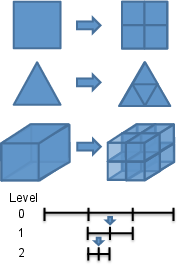Adaptivity System
h-Adaptivity

Self-similar refinement pattern utilized by MOOSE for adaptivity.
MOOSE employs -adaptivity to automatically refine or coarsen the mesh in regions of high or low estimated solution error, respectively. The idea is to concentrate degrees of freedom (DOFs) where the error is highest, while reducing DOFs where the solution is already well-captured. This is achieved through splitting and joining elements from the original mesh based on an error Indicator. Once an error has been computed, a Marker is used to decide which elements to refine or coarsen. Mesh adaptivity can be employed in both Steady and Transient Executioners.
Refinement Patterns
MOOSE employs "self-similar", isotropic refinement patterns, as shown in the figure. When an element is marked for refinement, it is split into elements of the same type. For example, when using Quad4 elements, four "child" elements are created when the element is refined. Coarsening happens in reverse, children are deleted and the "parent" element is reactivated. The original mesh starts at refinement level 0. Each time an element is split, the children are assigned a refinement level one higher than their parents.